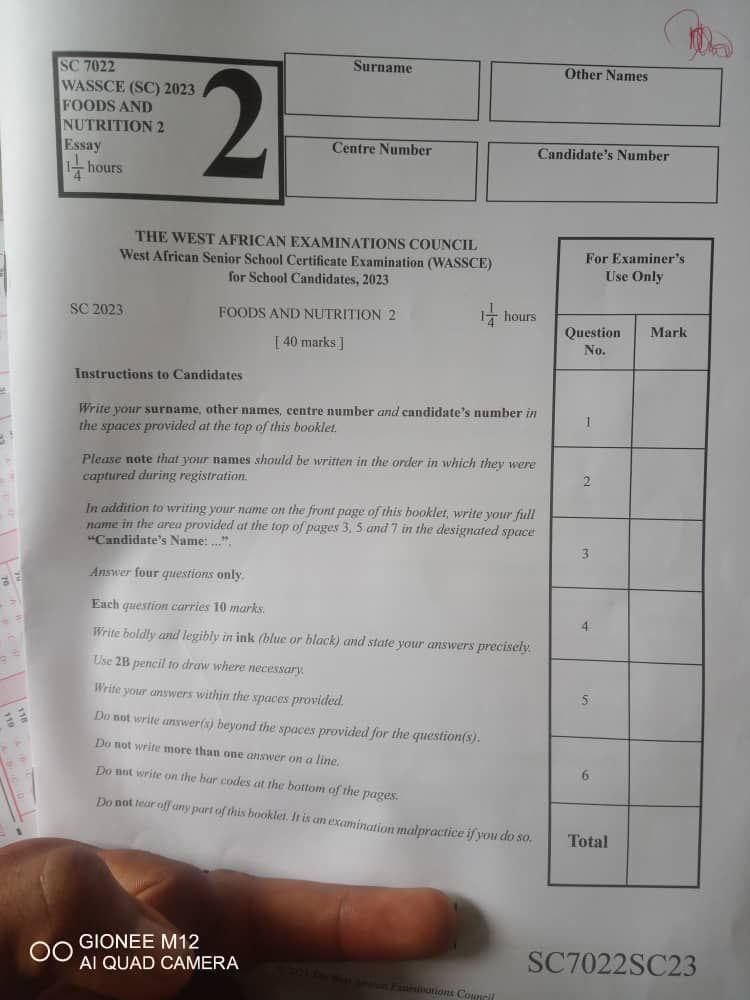To get 2023 WAEC Answers 1-2hrs before the exam, WhatsApp this
Refresh this page most often
TO GET ANSWERS SHARE THIS POST TO 5 WHATSAPP GROUP
.jpeg)
Foods and Nutrition 2 (Essay)
– 2:00pm – 3:15pm
(Answers Loading😍 Check Back But Wait! 💝Share this Post to Five WhatsApp Groups)
---ANSWERS LOADING👇---------------------------
PICK ANY TWO
(3b)
(i) ingredients
(ii) Amount of ingredients
(iii) The preparation instructions
Number 1
(a)
1. Grain legumes: These are legumes that produce edible seeds or grains, such as lentils, chickpeas, peas, and beans.
2. Forage legumes: These are legumes that are grown as feed for livestock, such as clover, alfalfa, and vetch.
(b)
1. Grain legume: Lentils (Lens culinaris) and chickpeas (Cicer arietinum)
2. Forage legume: Clover (Trifolium) and alfalfa (Medicago sativa)
(c):
1. Dal or lentil soup
2. Hummus (made from chickpeas)
3. Chana masala (spicy chickpea dish)
4. Vegetarian chili (made from beans)
(d)
1. High in protein: Legumes are an excellent source of plant-based protein, which is important for muscle growth and repair, as well as overall health.
2. Rich in fiber: Legumes are high in fiber, which can help regulate digestion, reduce cholesterol levels, and promote feelings of fullness, aiding in weight management.
5(a)
1. Removing moisture: The preservation method aims to remove moisture from the food, making it difficult for bacteria, mold, and other microorganisms to grow. Examples of these preservation methods include drying, dehydration, and freeze-drying.
2. Reducing the pH level: A low pH makes it difficult for bacteria to grow. Examples of this principle include pickling and fermentation.
3. Reducing oxygen availability: This principle involves the removal of oxygen, creating an anaerobic environment that is hostile to most aerobic microorganisms. An example of this can be seen in canned foods.
5(b)
1. To extend shelf life: Preservation methods can help extend the shelf life of food, allowing it to be stored for a more extended period.
2. To increase availability: The preservation of food can help to increase the availability of food in areas where it may otherwise be scarce.
3. To reduce food waste: By preserving foods, we can reduce the amount of food that is wasted each year.
4. To maintain nutritional value: Some preservation methods such as freezing can help maintain the nutrient content of food, ensuring that we get a supply of vitamins and minerals.
5. To provide convenience: Preservation of food can provide convenience by allowing food to be stored and used at a later time, making meal planning easier and more efficient.
(5c):
1. Canning: This involves preserving food in airtight containers and then heating them to destroy microorganisms that may cause spoilage. This method is commonly used for preserving fruits and vegetables, seafood, and meats.
2. Freezing: This method involves cooling food to below the freezing point to prevent the growth of microorganisms that can cause spoilage. Many types of food can be preserved through freezing, including fruits, vegetables, meats, and baked goods.
Foods and Nutrition 1 (Objective)
– 3:15pm – 4:15pm
(Answers Loading😍 Check Back But Wait! 💝Share this Post to Five WhatsApp Groups)
---LOADING-------------------------------------------

.png)






.png)
